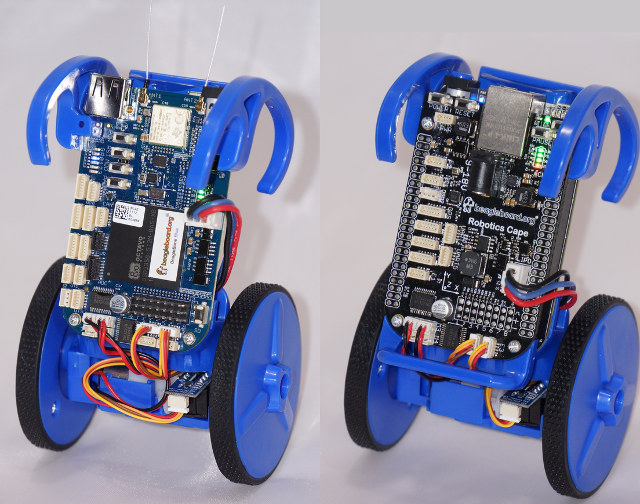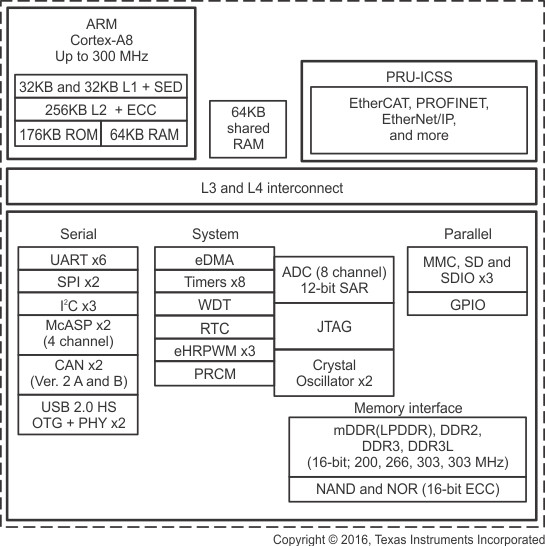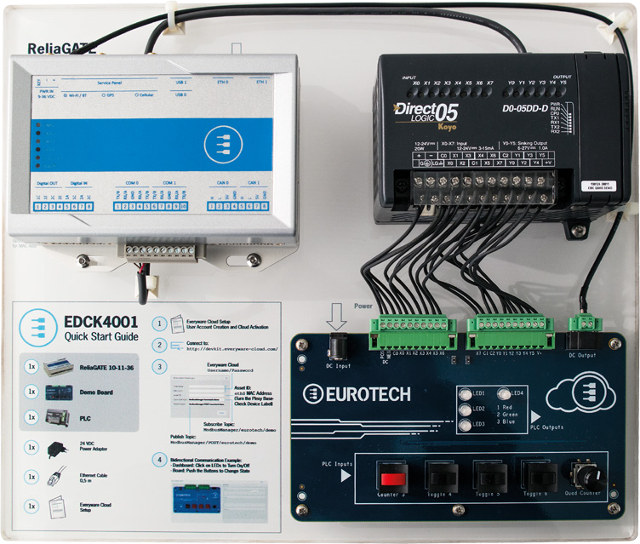Back in 2012, Texas Instruments introduced DLP LightCrafter pico projector evaluation module powered by a TMS320DM365 ARM9 processor @ 300 MHz running embedded Linux, and selling for $599. Since then, we have seen many products including projectors based on DLP technology such as standalone tiny projectors, Windows mini PCs, Android TV boxes, tablets, an even light bulbs. However, so far I can’t remember seeing any easy way to easily integrate DLP projector with the cheap ARM Linux development boards available today. Texas Instruments has now filled that void with DLP LightCrafter Display 2000 EVM that adds a pico-projector to BeagleBone Black (or Green) based on the new 0.2″ DLP2000 DMD (Digital Mirror Device) chip. The board is comprised of two subsystems: Light engine (top) with the optics, red, green, and blue LEDs, and the 640 × 360 (nHD) DLP2000 DMD configured to deliver around 20 lumens by default (this can […]
EduMIP Self-Balancing Robot Kit Based on BeagleBone Blue is Now Available for $50
BeagleBone Blue is a board designed for robotics projects, and one of those projects is EduMIP self-balancing robot that was first designed around BeagleBone Black and a robotics cape, but so far was not available for sale. Renaissance Robotics is now selling the kit, without board, for $50. The kit has been designed by UC San Diego Coordinated Robotics Lab in order to teach robotics to students, and it works with BeagleBone Blue, or BeagleBone Black with the Robotics Cape and an optional WiFi dongle. Some of the subjects that can be learned with eduMIP include: Dynamic modeling and feedback control (classical, state-space, adaptive, …) of unstable systems. Robot motion planning and collision avoidance. DC motor control via (built-in) H-bridges and encoder counters. Attitude estimation via (built-in) IMU and barometer. Communication via (built-in) WiFi (802.11b/g/n) and Bluetooth (4.1/BLE). Charging, balancing, protection, and monitoring of 2-cell LiPo (included). Multithreaded event-driven C programming […]
Texas Instruments Announces AMIC110 Sitara Industrial Communication Processor & Development Board
Texas Instruments Sitara AM335x SoCs integrate an ARM Cortex A8 processor @ up to 1GHz with a PRU-ICSS for industrial communication, but also include a display controller, an optional PowerVR GPU, and a rich-set of peripherals making it useful for a wide range of applications. The company has now launched AMIC110 Sitara processor with a Cortex A8 core @ 300 MHz, and a PRU-ICSS specifically designed for industrial Ethernet, and fieldbus communication. Texas Instruments AMIC110 Sitara processor key features and specifications: CPU – ARM Cortex-A8 processor @ up to 300 MHz with NEON, 32+32KB I/D cache, 256KB L2 cache, 176KB boot ROM, 64KB RAM External Memory Interfaces (EMIF) – mDDR(LPDDR), DDR2, DDR3, DDR3L Controller up to 1GB General-Purpose Memory Controller (GPMC) – 8-bit & 16-bit Asynchronous Memory Interface with up to Seven Chip Selects (NAND, NOR, Muxed-NOR, SRAM) 2x programmable Real-Time Unit Subsystem and Industrial Communication Subsystem (PRU-ICSS) supporting EtherCAT, […]
Linux 4.11 Release – Main Changes, ARM & MIPS Architecture
Linus Torvalds has just released Linux 4.11: So after that extra week with an rc8, things were pretty calm, and I’m much happier releasing a final 4.11 now. We still had various smaller fixes the last week, but nothing that made me go “hmm..”. Shortlog appended for people who want to peruse the details, but it’s a mix all over, with about half being drivers (networking dominates, but some sound fixlets too), with the rest being some arch updates, generic networking, and filesystem (nfs[d]) fixes. But it’s all really small, which is what I like to see the last week of the release cycle. And with this, the merge window is obviously open. I already have two pull request for 4.12 in my inbox, I expect that overnight I’ll get a lot more. Linux 4.10 added Virtual GPU support, perf c2c’ tool, improved writeback management, a faster initial WiFi connection […]
PocketBone Board Based on Octavo Systems OSD3358 SiP Fits into an “Altoids Smalls” Mint Tin Box
Last year, Octavo Systems introduced OSD3358 System-in-Package (SiP) that includes Texas Instruments Sitara AM3358 processor, 256MB to 1GB RAM, a PMIC and an LDO into a single package. Since then the SiP has been found in BeagleBone Black Wireless and BeagleBone Blue, and at the time of launch there was also some development around PocketBone, a tiny open source hardware Smalls mint tin sized board based on OSD3358, which is smaller than a CHIP board, but a little bigger than NanoPi NEO board. There’s now been some progress with prototypes of the board manufactured with the following specifications: SiP (System-in-Package) – Octavo Systems OSD3358 with TI Sitara AM3358 ARM Cortex-A8 processor @ up to 1 GHz, PowerVR SGX530 GPU, PMIC + LDO, and 512MB DDR3 Storage – micro SD slot USB – 2x micro USB port one for power, one OTG port Expansion – 10-pin header (unpopulated) with SPI, I2C, […]
$80 BeagleBone Blue Board Targets Robots & Drones, Robotics Education
Last year, we reported that BeagleBoard.org was working with the University of California San Diego on BeagleBone Blue board for robotics educational kits such as EduMiP self-balancing robot, and EduRover four wheel robot. The board has finally launched, so we know the full details, and it can be purchased for about $80 on Mouser, Element14 or Arrow websites. BeagleBone Blue specifications: SiP (System-in-Package) – Octavo Systems OSD3358 with TI Sitara AM3358 ARM Cortex-A8 processor @ up to 1 GHz, 2×32-bit 200-MHz programmable real-time units (PRUs), PowerVR SGX530 GPU, PMIC, and 512MB DDR3 Storage – 4GB eMMC flash, micro SD slot Connectivity – WiFi 802.11 b/g/n, Bluetooth 4.1 LE (TI Wilink 8) with two antennas USB – 1x USB 2.0 client and host port Sensors – 9 axis IMU, barometer Expansion Motor control – 8x 6V servo out, 4x DC motor out, 4x quadrature encoder in Other interfaces – GPIOs, 5x UARTs, 2x […]
MYD-C437x-PRU Development Board Leverages TI Sitara AM437x Programmable Real-time Unit
MYIR Technologies launched MYC-C437x system-on-module based on TI Sitara AM437X processor, and the corresponding MYD-C437x development board at the end of 2015, but the latter did not make use of the processor’s PRU-ICSS (Programmable Real-Time Unit Subsystem and Industrial Communication SubSystem) block. The company has now released a new version of the baseboard called MYC-C437x-PRU which exposes I/Os pins to leverage the PRU-ICSS and enable implementation of protocols like EtherCAT and Profibus.MYD-C437x-PRU industrial development board specifications: System-on-Module – MYC-C437x module with SoC – Texas Instruments AM437x ARM Cortex A9 processor @ up to 1GHz with PowerVR SGX530 GPU (AM4378/AM4379 only) System Memory – 256 or 512MB (default) DDR3 SDRAM Storage – 4GB eMMC Flash (reserved 256/512MB Nand Flash design), 16MB QSPI Flash (unpopulated by default), 32KB EEPROM Connectivity – Gigabit Ethernet PHY Storage – 1x micro SD slot Serial ports – 1x 3-wire RS232 debug serial port, 2x 5-wire RS232 serial […]
Eurotech EDCK 4001 Everyware Device Cloud Development Kit Includes IoT Gateway, PLC and Demo Board
Eurotech has recently EDCK 4001 “Everyware Device Cloud Development Kit” for professionals who wish to experiment with and/or develop IoT/M2M applications. It includes the company’s ReliaGATE 10-11 IoT gateway powered by Texas Instruments Sitara AM3352 Cortex A8 processor, DirectLOGIC DL05 PLC, and a control/demo board with buttons, LEDs, and rotary encoder, as well as all necessary cables and accessories. ReliaGATE 10-11 gateway specifications: SoC – Texas Instruments AM3352 ARM Cortex A8 processor @ 800MHz Memory – 512MB DDR3 Storage – 4GB eMMC flash, user accessible micro SD Slot Connectivity – 2x 10/100Mbps, WiFi and Bluetooth, optional Cellular connectivity and GPS via ReliaCELL USB – 3x USB 2.0 host ports; noise and surge protected Serial – 2x RS-232/RS-485 (Surge protected, RS-485 termination and Fail-safe Resistors); 1x Serial Console TTL CAN – 2x CAN 2.0b bus with 5V/100mA power out Digital I/O – 2x Digital Input 5V (TTL), 1KV opto-isolated – 2x […]










